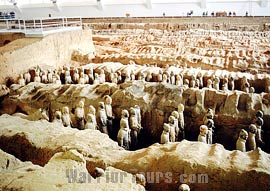- Big Wild Goose Pagoda & Tang Dynasty Palace
- Bell/Drum Tower & Daxingshan Temple
- City Wall
- Forest of Stone Steles Museum & Banpo Museum
- Great Mosque
- Huaqing Hot Springs & Xingjiao Temple
- Mausoleum of the First Qin Emperor
- Mausoleum of Western Han Emperor Liu Qi
- Terracotta Warriors
- Shaanxi History Museum
- Small Wild Goose Pagoda
- Famen Temple & Xianyang Museum
- Maoling Mausoleum & Tomb of Huo Qubing
- Mt. Huashan
- Qian Mausoleum & Zhaoling Mausoleum
Mausoleum of the First Qin Emperor

One of the greatest archaeological discoveries of the last century occurred in March 1974, near the city of Xian in the north-central province of Shaanxi. Farmers digging for water unearthed a fragment of a warrior figure, part of the Terra Cotta Army of Qin Shi Huangdi, who ruled between 246 and 210 BC. Just 15 km to the west of this site lies the mausoleum of the First Emperor. The mausoleum is located about 7.5 kilometers from Lintong county, Xian in Shaanxi province.
Almost one hundred pits containing the skeletons of horses and terra cotta grooms constituted the emperor's stables. Even hay was provided. Other pits held clay models of birds and plants and must have represented his parks. Some twenty tombs probably hold the remains of his councilors and retainers. At the center of the necropolis is a mound that marks the emperor's own grave; it has not yet been excavated. The historical records of the first century BC state that the tomb contained palaces and pavilions filled with rare gems and other treasures, and was equipped with crossbows to shoot automatically any intruders; the ceiling was inlaid with pearls to simulate the sun, stars and the moon, the floors and walls were lined with bronze to keep out water and mercury was pumped in to give the image of flowing rivers.
The construction of the Qin Mausoleum began as soon as Qin Shihuangdi ascended the throne in 246 BC. The work intensified after the conquest of the rival states employing 720,00 workers for a period of 39 years. Li Si - minister of Qin also supervised the project which was halted in 208 BC., when the capital was besieged by the rebel troops.
The site chosen was south of the Weihe River beside the slopes of Black Horse Mountain in what is now Lintong county, 30 kilometers (18 miles) from Xian. Screened by the five peaks of Lishan Mountain, the site coincides with traditional Chinese geomantic omens as an ideal burial place for emperors who held the belief that they would spend their afterlife in another world.
The appearance of the mausoleum is of a low earth pyramid with a wide base. It is said to have been plundered at least once, but no excavations have yet been done. Information about the construction of the mausoleum comes almost entirely from the brush of Sima Qian, the author of The Historical Records, which was written about a century after the fall of Qin.

Records state that the mausoleum, which covers 56.25 square kilometers, was a microcosmic replica of the Qin capital. Originally, double rectangular walls surrounded the mound with gates on the four cardinal points resembling the imperial city.
The inner wall measured 1,355 meters from north to south and 580 meters from east to west, with a perimeter of 3,870 meters. The length of the outer wall was 2,165 meters from north to south and 940 meters from east to west.
As the nucleus of the three concentric circles formed by the imperial palaces, sacrificial trenches and auxiliary tombs scatted around, the core tomb was set in the southern part of the inner city. Remains of hipped roofed imperial palaces, gardens and temples scattered mainly at the northern section of the inner wall; sacrificial trenches with the remains of animals and horses and a bronze cart trench were discovered at the western part between the walls and auxiliary royal tombs spread eastward from the city. These sites have enriched our knowledge and understanding of the Qin system, culture, clothing and material civilization.
| Admission Fee: | CNY 20 (Nov. 15 to Mar.15) CNY 40 (Mar. 16 to Nov. 14) |
| Opening Hours: | 07:30 to 18:30 |
| Recommended Time for a Visit: | Three hours |
| Bus Route: | 306 |
Page 1 2

